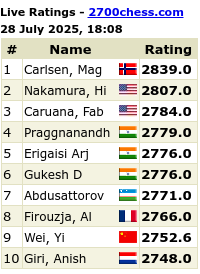When you gambit a pawn in the opening then it is fair to say that every piece exchange really favours the opposition if neither side is making great progress. I desperately wanted to find a King-side attack, but couldn't calculate enough moves ahead! (Later on this evening I will check with Fritz 13 to see what I missed ...) I began to get concerned when my pin against his Queen came to nothing and he had the prospect of winning my 'c' pawn with Rook and Queen bringing up the rear. When I finally saw no hope of winning I traded Queens in the hope of finding a way to draw, but I overlooked the capture of my 'f' pawn which resulted in me going two pawns down ... I was practically ready to resign on the spot. Experience has taught me though that in many endgame positions a draw can be achieved through perpetual check in the right position. Miraculously I managed to win his 'f' pawn after a bit of a struggle. He was then hoping to Queen his 'h' pawn but I know no less than 3 ways of drawing when just the enemy 'h' pawn and the Kings are left on the board ...
1) Get your King to h1. This will result in stalemate (Stalemate).
2) Confine his King to the 'h' file in front of his pawn (Confinement & Stalemate).
3) Draw by perpetual with my Rook giving the checks. (Draw by perpetual, 50 move rule)
As can be seen from Chess Diagram 2, the Rooks never got traded, therefore the 3rd option above was available to me! This is a 'book draw' (see Chess Diagram 2).
(I found out after the game that my opponent was graded almost 200 Elo points above me at 1720 Elo. It paid me in grading points not to give up - even when 2 pawns down in the endgame!)
As usual, any comments welcome ...
Chess Diagram 1 - Center Counter Game
1. e4 d5 2. exd5 Qxd5 3. Nc3 Qa5 4. b4 Qxb4 5. Rb1 Qd6 6. Nf3 c6 7. Be2 e6 8. Ne4 Qc7 9. d4 Nd7 10. O-O Ngf6 11. Bd3 Nxe4 12. Bxe4 Nf6 13. Bd3 Bd6 14. h3 Bd7 15. c4 b6 16. Re1 O-O 17. Ne5 c5 18. Nxd7 Nxd7 19. Be4 Rad8 20. d5 exd5 21. Bxd5 Bf4 22. Re7 Bxc1 23. Rxc1 Qf4 24. Qe1 Nf6 25. Re5 Nxd5 26. Rxd5 Rde8 27. Qd1 Re7 28. Rd8 Rfe8 29. Rxe8+ Rxe8 30. Rc2 Qe4 31. Kh2 h6 32. f3 Qe5+ 33. g3 Kh7 34. Qd3 g6 35. f4 Qe4 36. Qxe4 Rxe4 37. Kg2 Kg7 38. Kf3 Rd4 39. g4 a6 40. a4 Rd3 41. Kg2 Ra3 42. Rb2 Rxa4 43. Rxb6 Rxc4 44. Rxa6 Rxf4 45. Kg3 Rc4 46. h4 Rc3 47. Kg2 c4 48. h5 gxh5 49. gxh5 Rc1 50. Kf2 c3 51. Ke3 c2 52. Kd2 Rh1 0.5-0.5
Note: In the previous diagram I stopped writing the moves down on move 51. due to being within my final 5 minutes of time control.
Chess Diagram 2 - Drawn Position
1... Kg3 2. Rg8+ Kf3 3. Rf8+ ( 3. Rxg2 h1=Q+! ) 0.5-0.5
PGN Viewer courtesy of http://chesstempo.com/












